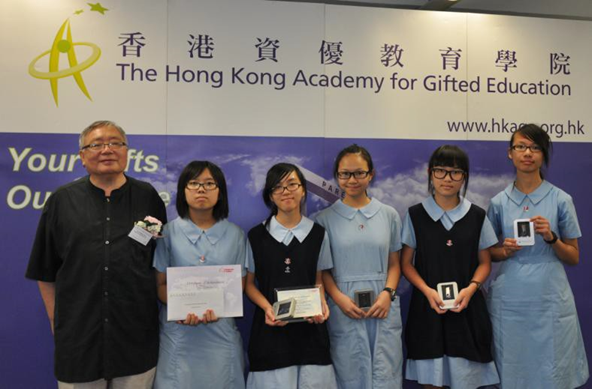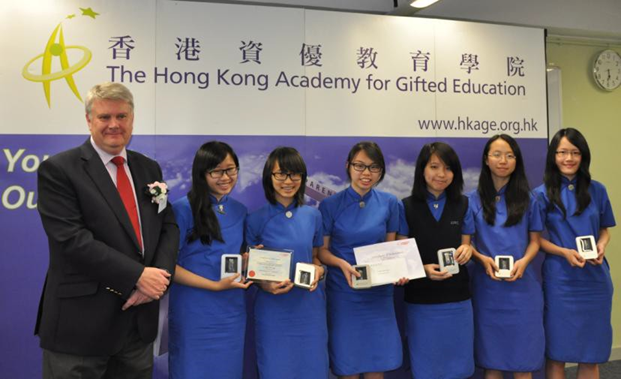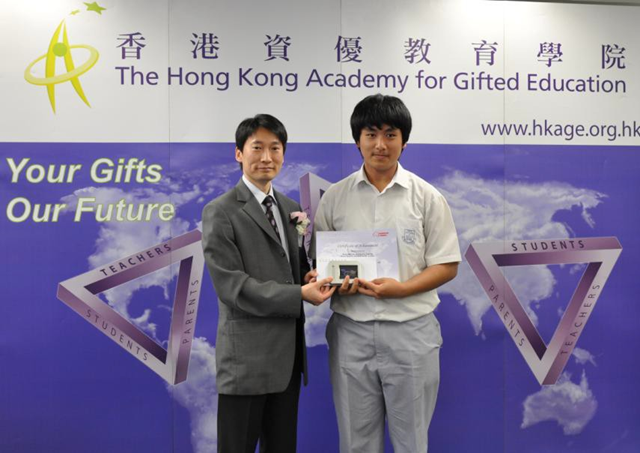Mathematics Resources Contest HK Students Applying Mathematics to Formulate the Direction of High Efficiency Buildings
(30 May 2012, Hong Kong) Hong Kong is a densely populated city while the land resources are limited and thus the public is keen on constructing high efficiency buildings. A group of Hong Kong students applied Mathematical theories together with creativity to the calculation of the efficiency rate of different buildings so as to find out which building shape requires less space. This also helped to identify the most effective land use strategies, which also sets a good example of how Mathematics helps to solve problems in daily life.
The Hong Kong Academy for Gifted Education (HKAGE) and Mathematical Database jointly organised the “Mathematics Resources Contest 2011-12”. The participated students formed in different teams and decided the problem-solving questions which related to the daily life on their own. The students then had to solve the problems by developing mathematical models. The prizes of the contest included “Best Contest Award”, “Best Presentation Award”, “Originality Award” and Honourable Mentions. The awardees would be given trophies and book vouchers. Their products would also be uploaded to Mathematical Database Website (http://mathdb.org) so that the works could be shared with those who are enthusiastic about Mathematics, which also facilitated idea exchange.
Dr Stephen Tommis, Executive Director of the HKAGE, said the contest attracted 36 teams from 18 schools to participate. Two teams out of the nine finalists were the student members of the HKAGE, who were also awarded the Honourable Mentions. He said, the contest enhanced the students’ enthusiasm about Mathematics. It also provided an out-of-classroom opportunity for students to train their creativity, analytical and problem solving skills. The Academy would continue to provide students with different choices of contests and learning experiences so as to develop their potential and widen their horizon.
Mr Wu Kai Chiu, Chairman of Mathematical Database, praised the creativity of the students. The students’ works contained a variety of topics including the shape of buildings, Slide Ruler, the parking floors of the lifts and the Magic Totem, etc. Professor Shum Kar Ping, Retired Professor of Department of Mathematics at CUHK cum one of the adjudicators of the contest, said the participated teams demonstrated creativity and team spirit. Some of the works were very practical, “Students have applied Mathematical theories to building design, which achieved a high level of application and benefits to the future development of the city. The application of Mathematics has an unexpected merit.”
The prize presentation of the contest was held successfully. The work “The Ideal Shape of Buildings” by Au Yeung Yung, Chan Ho Yan, Chung Ching Mei, Tam Kit Yu and Yau Lai Ying from St. Catharine’s School For Girls, Kwun Tong, won two awards, namely Best Content Award and Originality Award.
The work of “Magic Totem” by Au Yeung Yui Ying, Chow Ting Ying, Kam Hei Ting Joyce, Leung Wing Man, Luk Ching Yin and Wong Wing Yan from St Stephen’s Girls’ College, won Best Presentation Award. The “Magic Totem” was presented by a short movie, illustrating the relationships between Totem originated from a Japan animation and properties of circle and triangle.
The team of St. Catharine’s School For Girls said the public was very concerned about the housing issues recently so this stimulated them to set their topic into this way, “We saw many high rise buildings packed together. They occupied lots of area. But, do they have high efficiency rate? Thus, we would like to investigate which type of buildings could save space.” Chan Ho Yan, a Form Four student, said she joined the competition because she was keen on Mathematics and would like to give herself a challenge. She said, the topic chosen by the team had a social value. From the competition, she understood more about buildings and learnt different communication skills. She would analyse and solve problems by using mathematical ways more frequently. Ms See, the teacher who assisted the team, said the contest built up the confidence of the students and fostered their learning motivation, “Winning the prize also encourages students who were not willing to give a try. “
This winning team has studied the residential buildings in the shapes of “Linear”, ”Rectangle”, “L”, “H”, “Cruciform”, “Tower” ( 井 ), ”Windmill” and “Cylinder”. By using algebra and geometry, the students calculated which building shapes used the least space to cater for specified area of flats (For private residential building, each floor had 12 units with 48m2 each. For public residential buildings, each floor had 20 units with 36 m2 each. Each floor of the buildings had three lifts, corridors with the width of 1m and two stairs for fire escape). The study found out that private residential buildings in rectangular shape and public residential buildings in L shape used less space, whilst buildings in Windmill shape consumed the largest area since the corridors were long with many corners. For details, please refer to table 1.
Hung Man Ho, a Form Three student, was one of the members from the HKAGE Team who won the Honorable Mentions. He said the contest developed his interest in Mathematics. He was glad to work with team-mates from different secondary schools. He learnt the collaboration and communication skills from the contest. He hoped to join other competitions and activities organised by the HKAGE in the future.
Table 1:
| Private Residential Building (48 m2 x 12 units on each floor) | Public Residential Building (36 m2 x 20 units on each floor) | |||
| Shape of the Buildings | Total area used for building (m2) | Area of each floor: Area used for building each floor (3 decimal place) | Total area used for building (m2) | Area of each floor: 每层占地面积 (取小数后3位数字) |
| Rectangle | 608 | 1:1.056 | 776 | 1:1.078 |
| L Shape | 623.8 | 1:1.083 | 773.964 | 1:1.075 |
| Windmill | 690.25 | 1:1.198 | 841.76 | 1:1.169 |
*Extract from the proposal of “The Ideal Shape of Buildings”.
 |
| St. Catharine’s School For Girls, Kwun Tong won two prizes and the students received the awards from Professor Shum Kar Ping. |
 |
| Dr Tommis congratulated St Stephen’s Girls’ College on winning the Best Presentation Award. |
 |
| Mr Wu Kai Chiu presented the prizes to the team who got the Honourable Mention. |
 |
| Hung Man Ho, the student member of the HKAGE, represented his team to receive the award from Mr Abraham Tang, Associate Director (Student Programmes and Services), the HKAGE. |






